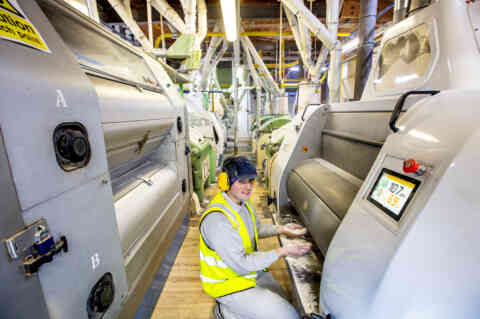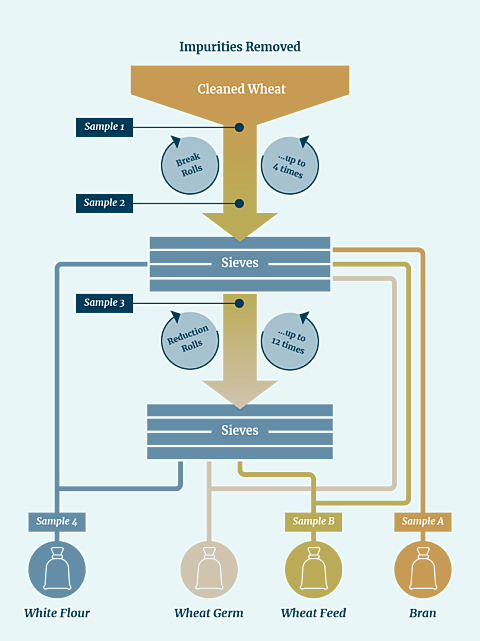The milling process

The flour milling process has evolved from wheat being ground between two large stone wheels (although this process does still occur in a few mills). In a roller mill the practice centres around separating the three components of a wheat seed – the white endosperm, the outer bran layers, and the wheat germ. These are each made up of different materials and, when separated and milled in isolation, the miller can produce flours that are finer and therefore better suited for today’s uses. For more detailed information on wheat structure click here.
The video below shows the layout and vast range of milling machinery that it used in a modern flour mill to convert wheat into flour. The video is shown with the kind permission of Buhler who make the machinery (www.buhlergroup.com).
Before the mill
Before it enters the mill floor, wheat is cleaned and then conditioned; after which, it passes through two cast steel "break" rollers which are set slightly apart from each other. The top roller runs at a slightly faster rate to the lower roller, and when wheat passes through it creates a shearing action, opening up the wheat grain. Opening the grain, rather than pulverising it, gives better access to the endosperm particles within.
At the mill
The various fragments of wheat grain are separated by size and weight and will pass through a complex arrangement of sieves and other machinery in order to isolate the three component parts of the wheat. Eventually, all the endosperm particles will pass through a series of smooth reduction rolls for final milling into white flour.
In a typical mill, there may be up to four break rollers (that shear open the wheat seeds and then further break open already sheared wheat) and 12 reduction rolls. Some particles of flour will pass through just one break roll and one reduction roll, while those closer to the layers of bran and germ will pass through multiple rolls.
The modern milling process allows the miller to remove the bran particles from the endosperm, grind the endosperm into flour, sift the ground stock, and remove flour produced at each stage.
Types of flours
Millers may blend different wheats prior to milling in order to achieve a specific grist. Additionally, they may also blend different flours in order to produce the exact product specification demanded by their customers. By blending together the many different flour streams produced by the mill, a miller can create further variations in features such as flour colour. Very white flours would come from the early streams only, while brown flours involve the use of most streams. Wholemeal flour is produced when all the streams, bran, germ, and flours are blended back together with nothing removed.
You can learn more about the Types of Flour produced by UK millers.

